Sanjeev Satheesh
NVIDIA Nemotron Nano 2: An Accurate and Efficient Hybrid Mamba-Transformer Reasoning Model
Aug 21, 2025



Abstract:We introduce Nemotron-Nano-9B-v2, a hybrid Mamba-Transformer language model designed to increase throughput for reasoning workloads while achieving state-of-the-art accuracy compared to similarly-sized models. Nemotron-Nano-9B-v2 builds on the Nemotron-H architecture, in which the majority of the self-attention layers in the common Transformer architecture are replaced with Mamba-2 layers, to achieve improved inference speed when generating the long thinking traces needed for reasoning. We create Nemotron-Nano-9B-v2 by first pre-training a 12-billion-parameter model (Nemotron-Nano-12B-v2-Base) on 20 trillion tokens using an FP8 training recipe. After aligning Nemotron-Nano-12B-v2-Base, we employ the Minitron strategy to compress and distill the model with the goal of enabling inference on up to 128k tokens on a single NVIDIA A10G GPU (22GiB of memory, bfloat16 precision). Compared to existing similarly-sized models (e.g., Qwen3-8B), we show that Nemotron-Nano-9B-v2 achieves on-par or better accuracy on reasoning benchmarks while achieving up to 6x higher inference throughput in reasoning settings like 8k input and 16k output tokens. We are releasing Nemotron-Nano-9B-v2, Nemotron-Nano12B-v2-Base, and Nemotron-Nano-9B-v2-Base checkpoints along with the majority of our pre- and post-training datasets on Hugging Face.
Nemotron-CC-Math: A 133 Billion-Token-Scale High Quality Math Pretraining Dataset
Aug 20, 2025Abstract:Pretraining large language models (LLMs) on high-quality, structured data such as mathematics and code substantially enhances reasoning capabilities. However, existing math-focused datasets built from Common Crawl suffer from degraded quality due to brittle extraction heuristics, lossy HTML-to-text conversion, and the failure to reliably preserve mathematical structure. In this work, we introduce Nemotron-CC-Math, a large-scale, high-quality mathematical corpus constructed from Common Crawl using a novel, domain-agnostic pipeline specifically designed for robust scientific text extraction. Unlike previous efforts, our pipeline recovers math across various formats (e.g., MathJax, KaTeX, MathML) by leveraging layout-aware rendering with lynx and a targeted LLM-based cleaning stage. This approach preserves the structural integrity of equations and code blocks while removing boilerplate, standardizing notation into LaTeX representation, and correcting inconsistencies. We collected a large, high-quality math corpus, namely Nemotron-CC-Math-3+ (133B tokens) and Nemotron-CC-Math-4+ (52B tokens). Notably, Nemotron-CC-Math-4+ not only surpasses all prior open math datasets-including MegaMath, FineMath, and OpenWebMath-but also contains 5.5 times more tokens than FineMath-4+, which was previously the highest-quality math pretraining dataset. When used to pretrain a Nemotron-T 8B model, our corpus yields +4.8 to +12.6 gains on MATH and +4.6 to +14.3 gains on MBPP+ over strong baselines, while also improving general-domain performance on MMLU and MMLU-Stem. We present the first pipeline to reliably extract scientific content--including math--from noisy web-scale data, yielding measurable gains in math, code, and general reasoning, and setting a new state of the art among open math pretraining corpora. To support open-source efforts, we release our code and datasets.
Llama-Nemotron: Efficient Reasoning Models
May 02, 2025Abstract:We introduce the Llama-Nemotron series of models, an open family of heterogeneous reasoning models that deliver exceptional reasoning capabilities, inference efficiency, and an open license for enterprise use. The family comes in three sizes -- Nano (8B), Super (49B), and Ultra (253B) -- and performs competitively with state-of-the-art reasoning models such as DeepSeek-R1 while offering superior inference throughput and memory efficiency. In this report, we discuss the training procedure for these models, which entails using neural architecture search from Llama 3 models for accelerated inference, knowledge distillation, and continued pretraining, followed by a reasoning-focused post-training stage consisting of two main parts: supervised fine-tuning and large scale reinforcement learning. Llama-Nemotron models are the first open-source models to support a dynamic reasoning toggle, allowing users to switch between standard chat and reasoning modes during inference. To further support open research and facilitate model development, we provide the following resources: 1. We release the Llama-Nemotron reasoning models -- LN-Nano, LN-Super, and LN-Ultra -- under the commercially permissive NVIDIA Open Model License Agreement. 2. We release the complete post-training dataset: Llama-Nemotron-Post-Training-Dataset. 3. We also release our training codebases: NeMo, NeMo-Aligner, and Megatron-LM.
Nemotron-H: A Family of Accurate and Efficient Hybrid Mamba-Transformer Models
Apr 10, 2025Abstract:As inference-time scaling becomes critical for enhanced reasoning capabilities, it is increasingly becoming important to build models that are efficient to infer. We introduce Nemotron-H, a family of 8B and 56B/47B hybrid Mamba-Transformer models designed to reduce inference cost for a given accuracy level. To achieve this goal, we replace the majority of self-attention layers in the common Transformer model architecture with Mamba layers that perform constant computation and require constant memory per generated token. We show that Nemotron-H models offer either better or on-par accuracy compared to other similarly-sized state-of-the-art open-sourced Transformer models (e.g., Qwen-2.5-7B/72B and Llama-3.1-8B/70B), while being up to 3$\times$ faster at inference. To further increase inference speed and reduce the memory required at inference time, we created Nemotron-H-47B-Base from the 56B model using a new compression via pruning and distillation technique called MiniPuzzle. Nemotron-H-47B-Base achieves similar accuracy to the 56B model, but is 20% faster to infer. In addition, we introduce an FP8-based training recipe and show that it can achieve on par results with BF16-based training. This recipe is used to train the 56B model. All Nemotron-H models will be released, with support in Hugging Face, NeMo, and Megatron-LM.
MIND: Math Informed syNthetic Dialogues for Pretraining LLMs
Oct 15, 2024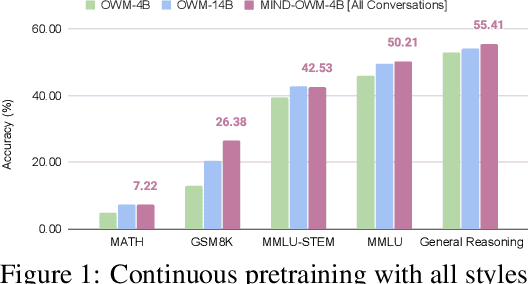

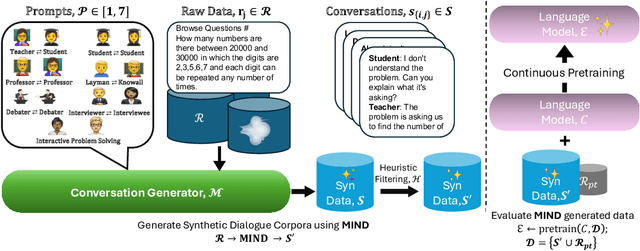

Abstract:The utility of synthetic data to enhance pretraining data quality and hence to improve downstream task accuracy has been widely explored in recent large language models (LLMs). Yet, these approaches fall inadequate in complex, multi-hop and mathematical reasoning tasks as the synthetic data typically fails to add complementary knowledge to the existing raw corpus. In this work, we propose a novel large-scale and diverse Math Informed syNthetic Dialogue (MIND) generation method that improves the mathematical reasoning ability of LLMs. Specifically, using MIND, we generate synthetic conversations based on OpenWebMath (OWM), resulting in a new math corpus, MIND-OWM. Our experiments with different conversational settings reveal that incorporating knowledge gaps between dialog participants is essential for generating high-quality math data. We further identify an effective way to format and integrate synthetic and raw data during pretraining to maximize the gain in mathematical reasoning, emphasizing the need to restructure raw data rather than use it as-is. Compared to pretraining just on raw data, a model pretrained on MIND-OWM shows significant boost in mathematical reasoning (GSM8K: +13.42%, MATH: +2.30%), including superior performance in specialized knowledge (MMLU: +4.55%, MMLU-STEM: +4.28%) and general purpose reasoning tasks (GENERAL REASONING: +2.51%).
Nemotron-4 340B Technical Report
Jun 17, 2024



Abstract:We release the Nemotron-4 340B model family, including Nemotron-4-340B-Base, Nemotron-4-340B-Instruct, and Nemotron-4-340B-Reward. Our models are open access under the NVIDIA Open Model License Agreement, a permissive model license that allows distribution, modification, and use of the models and its outputs. These models perform competitively to open access models on a wide range of evaluation benchmarks, and were sized to fit on a single DGX H100 with 8 GPUs when deployed in FP8 precision. We believe that the community can benefit from these models in various research studies and commercial applications, especially for generating synthetic data to train smaller language models. Notably, over 98% of data used in our model alignment process is synthetically generated, showcasing the effectiveness of these models in generating synthetic data. To further support open research and facilitate model development, we are also open-sourcing the synthetic data generation pipeline used in our model alignment process.
Topic Compositional Neural Language Model
Feb 26, 2018



Abstract:We propose a Topic Compositional Neural Language Model (TCNLM), a novel method designed to simultaneously capture both the global semantic meaning and the local word ordering structure in a document. The TCNLM learns the global semantic coherence of a document via a neural topic model, and the probability of each learned latent topic is further used to build a Mixture-of-Experts (MoE) language model, where each expert (corresponding to one topic) is a recurrent neural network (RNN) that accounts for learning the local structure of a word sequence. In order to train the MoE model efficiently, a matrix factorization method is applied, by extending each weight matrix of the RNN to be an ensemble of topic-dependent weight matrices. The degree to which each member of the ensemble is used is tied to the document-dependent probability of the corresponding topics. Experimental results on several corpora show that the proposed approach outperforms both a pure RNN-based model and other topic-guided language models. Further, our model yields sensible topics, and also has the capacity to generate meaningful sentences conditioned on given topics.
Robust Speech Recognition Using Generative Adversarial Networks
Nov 05, 2017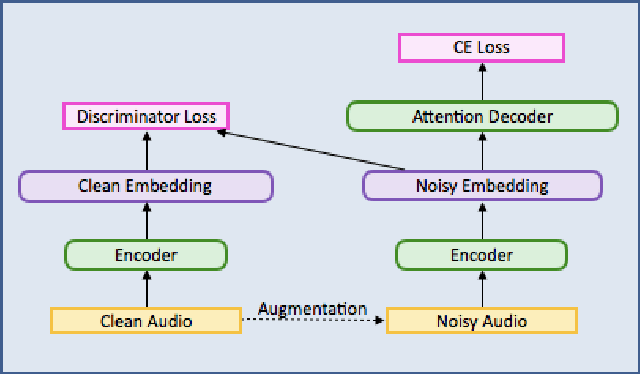
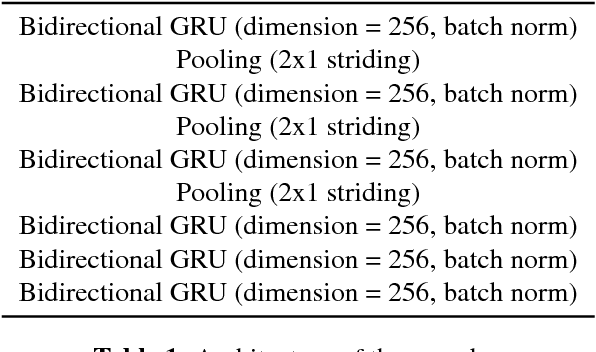
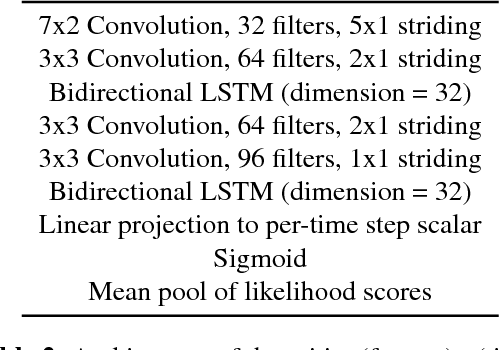

Abstract:This paper describes a general, scalable, end-to-end framework that uses the generative adversarial network (GAN) objective to enable robust speech recognition. Encoders trained with the proposed approach enjoy improved invariance by learning to map noisy audio to the same embedding space as that of clean audio. Unlike previous methods, the new framework does not rely on domain expertise or simplifying assumptions as are often needed in signal processing, and directly encourages robustness in a data-driven way. We show the new approach improves simulated far-field speech recognition of vanilla sequence-to-sequence models without specialized front-ends or preprocessing.
Cold Fusion: Training Seq2Seq Models Together with Language Models
Aug 21, 2017



Abstract:Sequence-to-sequence (Seq2Seq) models with attention have excelled at tasks which involve generating natural language sentences such as machine translation, image captioning and speech recognition. Performance has further been improved by leveraging unlabeled data, often in the form of a language model. In this work, we present the Cold Fusion method, which leverages a pre-trained language model during training, and show its effectiveness on the speech recognition task. We show that Seq2Seq models with Cold Fusion are able to better utilize language information enjoying i) faster convergence and better generalization, and ii) almost complete transfer to a new domain while using less than 10% of the labeled training data.
Gram-CTC: Automatic Unit Selection and Target Decomposition for Sequence Labelling
Aug 12, 2017



Abstract:Most existing sequence labelling models rely on a fixed decomposition of a target sequence into a sequence of basic units. These methods suffer from two major drawbacks: 1) the set of basic units is fixed, such as the set of words, characters or phonemes in speech recognition, and 2) the decomposition of target sequences is fixed. These drawbacks usually result in sub-optimal performance of modeling sequences. In this pa- per, we extend the popular CTC loss criterion to alleviate these limitations, and propose a new loss function called Gram-CTC. While preserving the advantages of CTC, Gram-CTC automatically learns the best set of basic units (grams), as well as the most suitable decomposition of tar- get sequences. Unlike CTC, Gram-CTC allows the model to output variable number of characters at each time step, which enables the model to capture longer term dependency and improves the computational efficiency. We demonstrate that the proposed Gram-CTC improves CTC in terms of both performance and efficiency on the large vocabulary speech recognition task at multiple scales of data, and that with Gram-CTC we can outperform the state-of-the-art on a standard speech benchmark.
 Add to Chrome
Add to Chrome Add to Firefox
Add to Firefox Add to Edge
Add to Edge